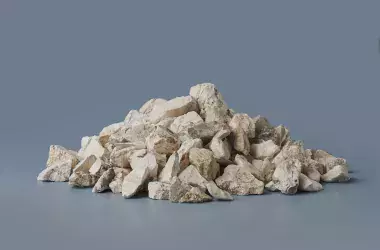Quicklime

What is Quicklime?
Quicklime, commonly also called lime, is a white, alkaline substance. Chemically it is known as calcium oxide (CaO). Quicklime is produced by heating limestone (calcium carbonate, CaCO3) to approximately 900°C (1,652°F).
This process, known as calcination or lime-burning, releases carbon dioxide and results in the formation of calcium oxide. Quicklime primarily consists of calcium oxide, with trace amounts of other chemical compounds, depending on the composition of the original limestone.
Properties of quicklime:
- Appearance: White or grayish-white solid
- Chemical Formula: CaO
- Melting Point: 2,570°C (4,658°F) (Boynton)
- Boiling Point: 2,850°C (5,160°F)
- Density: 3.34 g/cm³
- Solubility: Reacts with water to form calcium hydroxide (slaked lime), which has a solubility of 1.33 g CaO/L at 10°C (Boynton)
Applications of quicklime:
- Iron and steel manufacturing: Quicklime neutralizes the acidic oxides, acts as a flux, and removes impurities.
- Paper and pulp production: Used in the production of pulp and paper helping to bleach and purify the final product.
- Water treatment: Helps in softening water and removing impurities.
- Construction and building materials: Used in the production of concrete and mortar.
- Civil Engineering: Improves the stability and load-bearing capacity of clay-containing soil.
- Food Industry: It is used in food processing, such as in the production of sugar, where it helps to purify the raw product.
Lhoist’s brands for quicklime are: Akdolit®, Sorbacal®, Calexor®, and more.
Frequently Asked Questions (FAQs)
What is calcination, and why is it critical in quicklime production?
Calcination is the process of heating limestone (calcium carbonate, CaCO3) to high temperatures (approximately 900°C). This drives off carbon dioxide (CO2), resulting in the formation of calcium oxide (CaO). Calcination is essential as it transforms limestone into quicklime, which has various industrial applications.
How does quicklime improve the stability of soil in civil engineering projects?
Quicklime is mixed with clay-rich soil to improve its stability and load-bearing capacity. The chemical reaction with water reduces soil plasticity, enhances compaction, and creates a firmer, more stable base suitable for construction.
How does the composition of limestone affect the quality of quicklime?
The quality of quicklime depends on the purity of the original limestone. High-calcium limestone produces high-quality quicklime, while impurities like iron, aluminum, or silicon in the limestone result in a product with varying properties. For specific industrial applications, the desired composition of quicklime is carefully controlled.